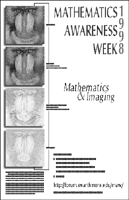Mathematics Awareness Week 1998
March 8, 1998

The 1998 Mathematics Awareness Week poster features four images of a mandrill: an original image; a wavelet image (300:1 compression) that preserves all but fine structure; a wavelet packet basis image (30:1 compression) that preserves fine structure of the mandrill's bristles; and a residual image. Each image pulls out different features of the original, which is the sum of the three. This mathematical transcription is useful for a more efficient and accurate storage and processing of imaging data; it can also provide tools for denoising and identifying structure in images. The images were provided by Ronald Coifman of Yale University.
Ronald Reagan proclaimed the first Mathematics Awareness Week in 1986 "to help encourage the study and utilization of mathematics." Seeming to anticipate the theme of this year's week, Mathematics in Imaging, April 26�May 2, 1998, his proclamation asserted that "the application of mathematics is indispensable in such diverse fields as medicine, computer sciences, space exploration. . . ."
Mathematics in Imaging
Indeed, mathematics is an essential element of imaging in these and many other settings. Medicine benefits from the techniques of tomography, including cutting-edge ideas like electrical impedance tomography that may greatly improve the detection of cancerous tumors, and MRI, where level set and marching methods can be used in the extraction of images of beating hearts.
Computer imaging depends on a whole range of mathematical tools. Wavelet transforms permit the efficient computation of life-like lighting effects in two-dimensional representations of three-dimensional scenes. Without proper illumination, the images created by computer graphics would appear flat and artificial rather than realistic and visually pleasing.
Storing computer images is another challenge. Familiar references like Microsoft's Encarta encyclopedia and its 7000 color images fit on a single CD-ROM because of fractal image compression techniques. Image compression is also one of the essential tools of space exploration. The scientists monitoring transmissions from the Mars Pathfinder, for example, will be receiving data at a mere 40 bytes per second (about 700 times slower than a typical modem!) when the space-craft reaches Mars. Compression routinely increases the effective transmission rate of image data by a factor of 15 or 20.
New techniques now being developed will raise compression ratios into the hundreds while still preserving essential features of the image. One of these new ideas, wavelet image compression, has already made possible the electronic storage and retrieval of the FBI's vast archive of fingerprint records.
Image restoration tools can extract detail that would otherwise be hidden in images from a wide range of sources, including satellites, medical imaging devices, telescopes, and even amateur video pictures submitted as courtroom evidence. Images from astronomical telescopes are cleaner to begin with if they have benefited from the control strategies of active and adaptive optics. These techniques minimize degradation from atmospheric blur and mechanical tremors through dynamic adjustment of the telescope lens and supports.
These and other aspects of mathematics in imaging are described in the 1998 Mathematics Awareness Week theme essay, by Paul Davis of Worchester Polytechnic Institute, at http://www.mathaware.org/index.html.
Organizing Activities for Mathematics Awareness Week
Mathematics Awareness Week depends ultimately on the efforts of local organizers, many of them students and faculty in secondary schools, colleges, and universities. The events they plan focus attention on mathematics, its development, its teaching, and its applications.
Activities from previous weeks are the best source of ideas for this year's Mathematics Awareness Week. An extensive sampling of such events is available from the Mathematics Awareness Week home page.
Origins of Mathematics Awareness Week
The idea of sponsoring a national Mathematics Awareness Week came in the fall of 1985 from Jim Murphy, a biostatistican at the University of Colorado who was then a Congressional Science Fellow in mathematics working in the office of Senator Pete Domenici. Ken Hoffman, who was working with the Joint Policy Board for Mathematics on Washington affairs while on leave from MIT, Jennifer Vance, legislative consultant to JPBM, and Kathleen Holmay, a public relations consultant to JPBM, helped obtain the presidential proclamation and a supporting joint resolution from both houses of Congress.
Subsequent celebrations of Mathematics Awareness Week were coordinated by Holmay and more recently by her colleague Mike Harris through JPBM. Beginning in 1998, Mathematics Awareness Week is being organized in rotation by JPBM's member societies, the American Mathematical Society, the Mathematical Association of America, and SIAM. SIAM is the organizer of Mathematics Awareness Week in 1998.

